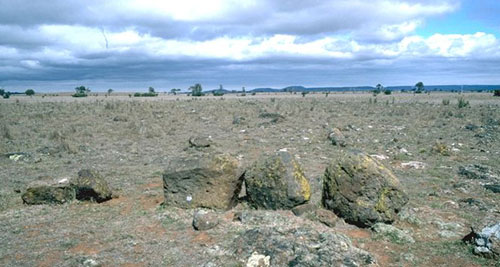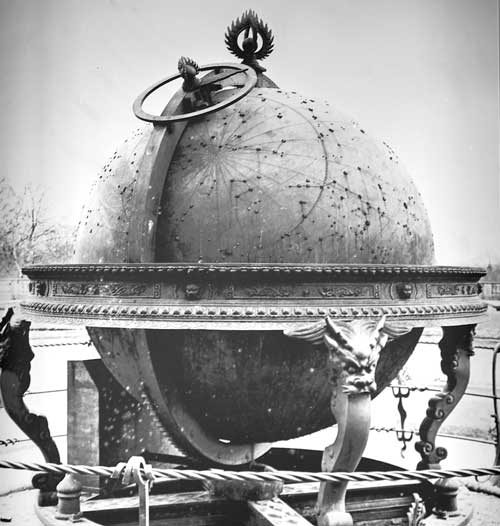Washington Monument as Sundial
Artist Yuri Schwebler turns the Washington Monument into a sundial in the snow, c. 1974. Thanks to Natalie Campbell and Kristina Bilonick for the tip!
Artist Yuri Schwebler turns the Washington Monument into a sundial in the snow, c. 1974. Thanks to Natalie Campbell and Kristina Bilonick for the tip!
The Corpus Clock was invented and designed by Dr John Taylor who brought together in its creation an exception team of craftsmen, engineers and skilled technicians. The clock’s face is a rippling gold disc, about 5 feet diameter, and displays the time by opening individual slits in the clock face backlit with blue LEDs instead of hands.
The dominating feature of the clock is a sculpture of a devouring metal insect which looks like a grasshopper or locust. The sculpture is actually the clock’s escapement. Taylor calls this beast the Chronophage (literally “time eater”, from the Greek). It moves its mouth, appearing to “eat up” the seconds as they pass, and occasionally it “blinks”. The creature’s constant motion produces an eerie grinding sound that suits its task. The hour is tolled by the sound of a chain clanking into a small wooden coffin hidden in the back of the clock.
Below the clock is an inscription mundus transit et concupiscentia eius (“the world passeth away, and the lust thereof”).
Conceived as a work of public art, the Chronophage reminds viewers in a dramatic way of the inevitable passing of time. Taylor deliberately designed it to be “terrifying”: “Basically I view time as not on your side. He’ll eat up every minute of your life, and as soon as one has gone he’s salivating for the next.” Others have described it as “hypnotically beautiful and deeply disturbing”.
More info: YouTube video explaining clock, chronophage website, and conspiracy theorists.
A new addition to the UVA school of architecture: a slot window in a stairwell that is shaped to catch the sun as it passes through the seasons. Â The angles of the window are tuned to the solstices. Thanks “William” Russell for the photo.
New York Marathon at mile 15 around 11am – Marilson Gomes dos Santos of Brazil, who later won, is at right in yellow. Runners just came from gnomon along Crescent Street, which will be the path of the shadow later in the day at 2pm.
The former curator of Harvard University’s Collection of Historical Scientific Instruments, William Andrewes, has become a “dialist,” or maker of sundials. His idea is to base the dial on an unusual type of map, and to center the map on the very spot where the dial will stand. The map’s meridians of longitude serve as the sundial’s hour lines, creating a union of time and space for that particular location—something no dialist or clockmaker had ever before achieved.
An inspiration for Andrewes’ Longitude Dial was a 1610 map by Nuremberg mathematician Franz Ritter (below, thanks Smithsonian website). It placed his city at the center, so that the meridians of longitude emanating from the North Pole could also serve as the hour lines of a Nuremberg sundial.
Article on Andrewes by Dana Sobel at Smithsonian.com
A project by Jiyeon Song
Using a complex array of perforations, the One Day Poem Pavilion‘s surface allows light to pass through creating shifting patterns, which–during specific times of the year–transform into the legible text of a poem. The specific arrangements of the perforations reveal different shadow-poems according to the solar calendar.

Stone arrangements in Victoria, Australia, such as a detail of the Wurdi Youang above (photo by Clive Ruggles) are possibly related to the extensive system of Australian Aboriginal astronomy.
More info: Astronomy of the Boorong paper, and the book Dark Sparklers.
Central tower as (proposed) gigantic sundial:
In the New York World’s Fair of 1939, a hugely popular exhibit was Democracity: a gigantic diorama of a utopian society set in 2039. From twin rotating balconies, the visitors looked down on what was supposed to be “a perfectly integrated garden city of tomorrow” and surrounding countryside as seen from seven thousand feet up. The city was a carefully planned community built on the shores of a river with the streets radiating out from a central tower–a perfect giant urban sundial setup, (although this may not have been what they had in mind).

Designed by ad agency Leo Burnett with the input of an engineer, the billboard features a real sundial whose shadow falls on a different breakfast item each hour until noon, when the shadow of the McDonald’s arches are dead center. The billboard, which went up near the intersection of Clark and Addison on Friday, is the latest in a campaign aimed at urging Chicagoans to turn to McDonald’s for breakfast.

The Beijing Observatory is a pretelescopic observatory in Beijing, China, and is one of the oldest observatories in the world. The tools used were built in 1442 during the Ming Dynasty. It has a number of bronze instruments, including a celestial globe. More info.

